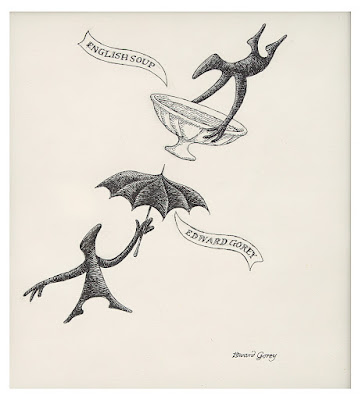Goreyana's Crystal Anniversary
This week at Goreyana, we celebrate 15 years of all things Edward Gorey. I began the Goreyana blog on October 5, 2008 as a way to honor the extraordinary talent and genius of Edward Gorey. The Gotham Book Mart had closed in 2007 and at that time there were very few venues to learn about Mr. Gorey's body of work. Feeling isolated as a collector, I envisioned this blog as a place to share information, stories, and hopefully to spark conversations between fans and collectors. Today, Gorey's ongoing popularity has led to numerous blogs, articles, Facebook groups, exhibitions, and themed events dedicated to reveling in the works of Edward Gorey. I would like to thank everyone who has read my posts over the years. I truly enjoy all the interactions and enjoyment that my blog has inspired. Thank you!
Now, let us begin our 16th year with blog post #724!
1064 Watercolor Paintings
Over
the years Edward Gorey produced five different limited edition
publications that were hand colored: The Lavender Leotard 1973, Dogear
Wryde Postcards: Interpretive Series 1979 (1980), The Eclectic
Abecedarium 1983, Q.R.V. 1989, and The Dripping Faucet 1989. The
Interpretive Series is the most elaborately painted of these
titles. I have set 29 in my personal collection.


Photographs of Edward Gorey's home show an environment that is overflowing with books, art, objet d'art, furniture, and cats. The casual viewer might think that the artist lived in world of clutter and chaos, but first impressions can be deceiving. Edward Gorey was actually a very organized person with an obsessive dedication to his work, and his combination of talent and organizational skills were put to the test with the Interpretive Series. The painting of these postcard sets was a task that he set for himself and he rose to the challenge spectacularly.

Comparing images side by side from sets that have been come on the market over the years from booksellers, auction houses and online auction sites, we find that there are no major differences between the sets even though they are all individually hand painted. Beginning with the decorated envelope that houses each set, and making allowances for differences in scans, color correction and photography, the paintings are shockingly similar. I purchased my set at The Gotham Book mart in the spring of 1980 just after they had arrived and remember them all standing together in an open topped box in the small back room at the store. In typical bookstore fashion, the front of each envelope had been labeled lightly in pencil by Andreas Brown stating the number or letter of the set enclosed.

Indolence is the only card in the set that features a capitol letter "I" in a horizontal orientation, so it tends to be featured most often in seller's listings. All the cards of Indolence pictured above are virtually the same, with the colors and shadows of each painted card being obviously hand painted but remarkably consistent. Even the free form shadow under the figure has the same shape and color tone.
In order for Edward Gorey to paint the cards with so little variation from one to the next, he had to have lined up all the cards and painted them production line fashion rather than painting a complete set of 13 cards and moving on to the next set. Concentrating on one image at a time would be the only way to achieve the consistency between the cards. Watercolor can be a tricky medium to master due to the fact that the application of a second color can change what was previously painted.


Image of Edward Gorey's home from Kevin McDermott's book, Elephant House, Pomegranate 2003.












































.jpeg)







